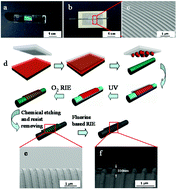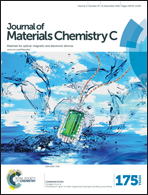Fabrication of metallic patterns on highly curved substrates via nanoimprint lithography in association with an etch-in process†
Abstract
In this paper, we demonstrate the fabrication of metallic patterns on both planar and highly curved substrates via nanoimprint lithography in association with an etch-in process. First, the resist pattern is fabricated on the surface of a metal coated substrate via UV-curing nanoimprint lithography using a hybrid soft nanoimprint mold and the double transfer method. After the resist pattern was etched through by reactive ion etching (RIE), the sample is immersed in an etchant to fabricate metallic patterns using the resist pattern as the etching mask. An ammonium cerium nitrate/acetic acid system is used as the etchant to fabricate Cr patterns and the Fe3+/thiourea etching system is used to fabricate Au patterns. High quality 70 nm deep Cr gratings and 80 nm deep Au gratings with 550 nm pitch and 275 nm linewidth are obtained. Additionally, the linewidth of Cr patterns can be tuned from 275 nm to 95 nm by changing the etching time. Furthermore, a 550 nm pitch Cr grating is patterned on the cylindrical surface of a 125 μm-diameter optical fiber and a surface relief fiber Bragg grating with a groove depth of 330 nm is fabricated via RIE using the Cr mask. This method is universally used for fabricating metallic patterns on different substrates and it greatly widens the process window compared to the lift-off process.


 Please wait while we load your content...
Please wait while we load your content...